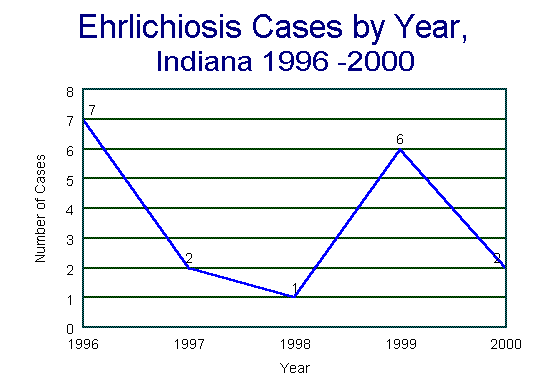
2000 Indiana Report of Infectious Diseases |
View CDC's Human Ehrlichiosis in the United States page
Rates presented are per 100,000 population and are based on the U.S. 2000 Census.
Cases = 2
Indiana had 2 reported cases of human monocytic ehrlichiosis in 2000. For the five-year period 1996-2000, 18 cases were reported, as illustrated in Figure Ehr1. Figure Ehr2 shows those counties which have reported cases of ehrlichiosis for the five-year period 1996-2000. Figure Ehr3 compares reported cases of ehrlichiosis by sex for the five-year period 1996-2000. The female to male case ratio is 1:3.5. The difference in sex distribution may be related to differences in occupational and recreational exposures. For the five-year period 1996-2000, females with reported cases of ehrlichiosis ranged in age from 7 to 75 years, with a mean age of 47.5. During that same period, males with reported cases ranged in age from 3 to 79 years, with a mean age of 46.2.
Ehrlichiosis is an acute febrile disease whose spectrum of illness ranges from so mild that it requires no medical treatment to a life-threatening or fatal disease. Most commonly reported symptoms are fever, headache, anorexia, nausea, myalgia, and vomiting. Thrombocytopenia and abnormal liver function test results, particularly increased hepatic transaminase levels, have also been noted. The disease resembles Rocky Mountain spotted fever without the rash. Diagnosis requires laboratory confirmation by indirect fluorescent antibody testing. Treatment with a tetracycline or chloramphenicol for pregnant women and children younger than age 8 has been reported to be effective.
Ehrlichiosis was first recognized in the United States in 1986. The causative agent of human monocytic ehrlichiosis (HME) is Ehrlichia chaffeensis, a new member in the genus of Ehrlichia, family of Rickettsiaceae. Ehrlichia chaffeensis is closely related to E. canis, the causative agent of canine ehrlichiosis. Epidemiological data indicate that most cases of HME are found in the South Central or Southeastern United States. Amblyomma americanum, the lone star tick, is a suspected vector.
An unspecified Ehrlichia causes human granulocytic ehrlichiosis (HGE). This organism is closely related to both E. phagocytophila and E. equi. Ixodes scapularis, the deer tick, is the most important vector. So far HGE has been limited to the Upper Midwest and East Coast states. To date, no human infections have been identified in Indiana.
Back to Top of Article
Back to Table of Contents
|
|
Back to Reference in Text
Back to Top of Article
|
Figure Ehr2: Counties with Reported Cases of Ehrlichiosis, Indiana, 1996-2000 |
|
|
Back to Reference in Text
Back to Top of Article
|
|
Back to Reference in Text
Back to Top of Article
Back to Table of Contents [an error occurred while processing this directive]